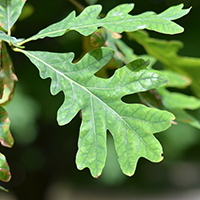What white oak looks like
Size and shape
- Large tree, usually 20 to 30 metres tall.
- Can grow to be more than 35 metres tall.
- Trunk reaches 50 to 120 centimetres in diameter.
Leaves
- Bright green leaves with paler green undersides.
- 10 to 20 centimetres long with 7 to 9 lobes.
- Leaves turn red-purple in the fall before falling off.
Bark
- Whitish to pale gray, usually with long scales.
Flowers
- Long, slim, green-brown “catkins”.
Fruit
- Acorns are 1.2 to 2.5 centimetres long.
- Acorns take one year to fully grow.
- Acorns drop off in the fall once they are ripe.
Where white oak is found
White oak is found in Southern Ontario.
What you need to know to grow white oak
- Moisture: can tolerate a variety of moisture levels.
- Soil: can tolerate a variety of soils.
- Shade: prefers full sun.
- Cautions:
- Planting: with its deep rooting system, white oak should not be planted close to septic systems or drainage tiles.
- Disease: oak wilt is caused by an invasive fungus that has been found in Southern Ontario. To minimize the risk of oak wilt, save pruning for before April and after July, when beetles thought to transport the fungus are less active.
Benefits and uses of white oak
Wildlife benefits
- Birds, bears, rodents, squirrels and other animals eat the acorns.
- Trees provide perching and nesting sites for songbirds.
- Many birds and mammals use the twigs and leaves for nesting material.
- Large oaks provide denning sites for mammals such as raccoons and squirrels.
Commercial uses
White oak is one of the most important commercial hardwoods. The wood is waterproof, durable and elastic. Uses include:
- barrels and casks
- shipbuilding
- railroad ties
- lumber (furniture, flooring)
- firewood
Current research
To learn about our research on white oak, visit our science publications catalogue and search for “white oak.”
Fun facts about white oak
- It can live for several hundred years.
- It is an adaptable tree that will grow almost anywhere.
- It is a popular choice for whiskey barrels.
- In peak years, large trees can produce 10,000 acorns.
Updated: January 10, 2024
Published: July 18, 2014



